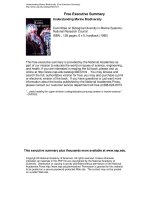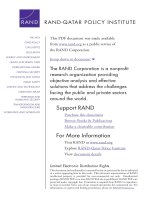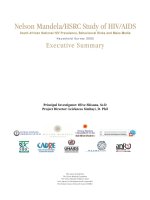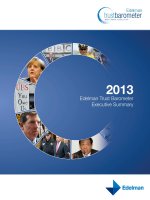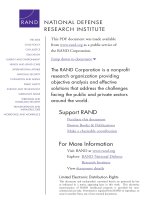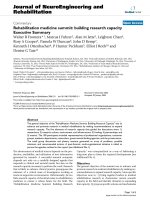executive summary
Bạn đang xem bản rút gọn của tài liệu. Xem và tải ngay bản đầy đủ của tài liệu tại đây (1.95 MB, 43 trang )
<span class="text_page_counter">Trang 2</span><div class="page_container" data-page="2">
<b> EXECUTIVE SUMMARY </b>
</div><span class="text_page_counter">Trang 3</span><div class="page_container" data-page="3">LifeTracks is a new service brand wishing to develop and implement a digital marketing strategy to promote its unique concept, called song-task association. As identified by the primary and secondary research, the audience that would most benefit from the app is young people aged 18-24 years old with ADHD and symptoms of ADHD. The objective of the digital creative approach presented in this report, which will be deployed across Instagram and TikTok, is to position LifeTracks as the go-to solution for ADHD diagnoses and symptoms to self-manage daily tasks, raise awareness, and ultimately increase tangible value for the brand. Based on insights found within various methodologies such as SOSTAC and Storyscaping, we developed ideal personas, identified "One task at a time" as the tagline for LifeTracks, and concluded that LifeTracks should work closely on its social media profiles to effectively communicate and strongly engage with the target audience. The outlined marketing strategy and recommendations, which will be detailed further in this work, will help LifeTracks build and maintain that meaningful and long-lasting relationship with its audience.
</div><span class="text_page_counter">Trang 5</span><div class="page_container" data-page="5"><b>TABLE OF FIGURES </b>
Figure 1: SOSTAC Methodology 8
Figure 2: Storyscaping Methodology 8
Figure 3: RACE Model 9
Figure 4: Target Market 13
Figure 5: Most-identified ADHD symptoms 13
Figure 6: Touchpoints 14
Figure 7: TikTok & Instagram monthly active users 15
Figure 8: App competitors analysis 16
Figure 9: Social media Competitors analysis 16
Figure 10: Personas 17
Figure 11: Project Objectives 18
Figure 12: Perceptual Map 18
Figure 13: Storyscaping Model 19
Figure 14: S.M.A.R.T Objectives 20
Figure 15: User journey 21
Figure 16: ADHD Instagram accounts 22
Figure 17: Instagram Ads mock-up 23
Figure 18: Referral Scheme 24
Figure 19: Instagram Story examples 25
Figure 20: Instagram Posts examples 25
Figure 21: Global Best time for Instagram posts 27
Figure 22: TikTok KOLs about ADHD 28
Figure 23: Design recommendation 28
Figure 24: KPIs and Measurements 29
</div><span class="text_page_counter">Trang 6</span><div class="page_container" data-page="6"><b> INTRODUCTION </b>
</div><span class="text_page_counter">Trang 7</span><div class="page_container" data-page="7">The brief for this work is to develop a digital marketing strategy for LifeTracks®, which is a behavior change platform that harnesses the power of music to help people improve their health and mental wellbeing. As stated in the brief, the biggest observed challenge for LifeTracks® is the lack of perceived benefit vs. the effect to adopt or use the app.
Although its audience is inevitably a broad one, findings from our primary and secondary research suggested that ADHD diagnoses and symptoms aged 18–24 years old will be the most relevant segmentation, and supporting in daily life is the core category associated with them.
A variety of methodologies would be used to tap into these potential audiences and drill down into the shared experiences between the brand (LifeTracks®) and the consumer, addressing the identified challenges. Details about our research, the processes that we used, as well as the data outcomes and final results we have reached will be presented throughout this report.
</div><span class="text_page_counter">Trang 8</span><div class="page_container" data-page="8"><b> METHODS & SAMPLES </b>
</div><span class="text_page_counter">Trang 9</span><div class="page_container" data-page="9"><b>I - METHODS </b>
Various methodologies were conducted to help define and refine the project during different stages.
● SOSTAC
The SOSTAC methodology was used as a framework to help structure and assess the project. It helped understand the problems that the brand is facing, execute a creative digital strategy for the brand and devise the means to achieve the objectives. These steps will be detailed later in the report.
Figure 1: SOSTAC methodology (Simon Swan, 2021)
● Storyscaping
Figure 2: Storyscaping methodology (Legorburu, G. and McColl, D., 2014)
</div><span class="text_page_counter">Trang 10</span><div class="page_container" data-page="10">Storyscaping model helped identify an organising idea that aligned with the developed personas.
● RACE framework
Figure 3: RACE model (Simon Swan, 2021)
The RACE framework was applied as a tool to build a well-formed media plan, locate different touchpoints in a conversion funnel, and define the measurement parameters to track and manage the effectiveness and performance of the overall strategy in each phase.
</div><span class="text_page_counter">Trang 11</span><div class="page_container" data-page="11"><b>II - SAMPLES </b>
● Primary research
Combining both qualitative and quantitative research, an online survey and structured interviews with a focus group of five people aged 18–24 years old with symptoms of ADHD were conducted.
The survey was made available online via Microsoft Form, while the interview was conducted online via Zoom. The 57 responses gathered from the survey and the results from the interview helped identify the positioning of the LifeTracks app, users' insights and different touchpoints to reach the target audience.
● Secondary research
Several articles and online databases (e.g. Statista) were used as secondary research to help with the project, especially in building a deep understanding of ADHD traits and their behaviour on social media. These findings then helped determine which platforms and how they will be used to drive the project towards the outlined objectives.
</div><span class="text_page_counter">Trang 12</span><div class="page_container" data-page="12">
<b> S.O.S.T.A.C </b>
</div><span class="text_page_counter">Trang 13</span><div class="page_container" data-page="13"><b>Situation Analysis </b>
● Internal Analysis
LifeTracks is a new service brand that aims to support the cognitive conditions and mental well-being of ADHD diagnoses and symptoms throughout the process called song-task association. Whilst there are apps for specific well-being problems, the ‘song-task association' concept is unique to LifeTracks. Given the function of the app, our interview's participants stated that they anticipate LifeTracks can help them stay organised and complete daily tasks more effectively.
The biggest challenge that LifeTracks is now facing is how to reach the target audience and develop a meaningful, ongoing relationship with them. To develop a frictionless on-boarding process and a successful retention strategy, further insights into the target market and competitors will be analyzed in the following sections.
● Target Market
Attention Deficit Hyperactivity Disorder (ADHD) is a condition that affects people's behaviours, making them act on impulse, be restless or struggle to focus (NHS, 2018). A report by Statista (2021) concluded that 157,500 18–24 year olds in the UK are thought to have ADHD.
Online survey results also showed that most people (61%) haven't been diagnosed with ADHD (Figure 4), but all of them actually showed a lot of ADHD symptoms (Figure 5). This means the majority of young people, who are aged 18–24 years old, do indeed need a self-help app like LifeTracks® to stay organised and get their daily tasks done.
</div><span class="text_page_counter">Trang 14</span><div class="page_container" data-page="14">Figure 4 : Online survey result - Target market
The biggest challenges for people with ADHD symptoms are staying focused, being less forgetful, and staying fixated on a task (Figure 5). Haydn Brooklyn, who self-identified with ADHD 2 years ago, also stated that these symptoms affected his productivity at work as he couldn't manage to prioritise and focus on any tasks. These truths about executive dysfunction unlocked users' needs and helped determine the organising idea for the campaign, which will be detailed later in the report.
Figure 5: Most-identified ADHD symptoms
While it is common knowledge that background noise may distract neurotypical attentive people, specific use of music, in contrast, increases the level of dopamine in inattentive people, improving their cognitive functions and ability to focus (Söderlund et al., 2010). Respondents
</div><span class="text_page_counter">Trang 15</span><div class="page_container" data-page="15">music. Hence, it is obvious that the USP of LifeTracks® (song-task association feature) can help its target audience achieve their goal of leading a more structured life.
● Touchpoints
While social media is increasingly used for communicating about mental health (Schein, Wilson, & Keelan, 2010), 81.1% of young people with ADHD reported using Instagram regularly (Anderson & Jiang, 2018) and largely sharing external content (e.g., memes) to amuse their friends (Anne E. Dawson, 2019). This is in accordance with our online survey results where Instagram and TikTok were recorded as the most regular-used platforms among our target audience (Figure 6).
Figure 6: Touchpoints
Bloomberg (2021) found that TikTok draws 17 million active users monthly in the UK and nearly a quarter of them aged 15-25 (Statista Research Department, 2021). Whereas the number of
</div><span class="text_page_counter">Trang 16</span><div class="page_container" data-page="16">
Figure 7: TikTok & Instagram monthly active users (Business of Apps, 2021)
To explain further, respondents from the structured interviews stated that TikTok and Instagram were preferred because the content is presented in a more fun and fast-paced way. It was also reported that all of the respondents joining the ADHD community/group on Facebook, following Instagram accounts about ADHD or searching for #ADHD on TikTok to pick up relatable content.
These findings from both primary and secondary research suggested that the marketing strategy should be tailored towards these two channels to strongly engage with potential consumers.
● Competitors Analysis
As suggested from the primary research, Calm and Headspace are the main recognised competitors of LifeTracks as they set the same objective of helping improve overall mental health using music therapy.
</div><span class="text_page_counter">Trang 17</span><div class="page_container" data-page="17">Figure 8: App Competitors analysis
Three respondents from the interviews also mentioned Calm and Headspace as their most favourite and asserted how much they enjoy the experience with customizable audio and visual within the apps. The most important factor that keeps them interested is the step-by-step instructions, which won't make them feel intimidated or overwhelmed.
To communicate with their users, both Calm and Headspace are utilising social media platforms. It can also be seen that our competitors have a very high engagement rate and a powerful online presence (Figure 9), whereas LifeTracks® hasn't got its own social media profile yet.
</div><span class="text_page_counter">Trang 18</span><div class="page_container" data-page="18">● Personas
Findings from the primary and secondary research above helped identify key insights and develop ideal personas for the LifeTracks app as Grace (she/her, 24) and Todd (he/him, 19).
Figure 10: Personas
Overall, both ADHD diagnoses and symptoms anticipate a more structured life with the
</div><span class="text_page_counter">Trang 19</span><div class="page_container" data-page="19">onboarding process are the most important things to support them in getting their tasks done. To ensure an enriching UX, LifeTracks® can also motivate users towards their goals by creating a daily, monthly, or annual achievement board that showcases how great they’re doing (i.e., how many assigned tasks they've done).
<b>Objectives </b>
As set in the brief and findings from our primary and secondary research, main issues that the marketing project should address have been segmented as follows:
Figure 11: Project objectives
■ Perceptual Map
A perceptual map was used to place LifeTracks® in relation to its two competitors (the Calm and Headspace apps) in terms of public awareness and perception of its interface.
</div><span class="text_page_counter">Trang 20</span><div class="page_container" data-page="20">It can be seen that LifeTracks® is a brand that now has low awareness and a menu-based interface, which is easy to navigate but surprisingly too distracting for users. In fact, ADHD people would prefer an app with less information on one screen (i.e., isolating assigned tasks) but more graphics and animations. This means a shift must be made to make LifeTracks® a more competitive app.
■ Storyscaping Model
The four pillars of the Storyscaping model were created to determine the shared values and shared experience between the brand (LifeTracks®) and the consumers (people with ADHD and symptoms of ADHD aged 18-24).
Figure 13: Storyscaping Model
“One task at a time” was identified as the tagline for LifeTracks®, which would govern the creation of the following marketing strategy.
</div><span class="text_page_counter">Trang 21</span><div class="page_container" data-page="21"><b>Strategy</b>
■ S.M.A.R.T objective
Incorporating five components of the S.M.A.R.T objectives and in comparison to the historical accomplishments of Calm (Appendix A) and Headspace (Appendix B), which are our main competitors in the mental health and wellness landscape, KPIs for LifeTracks were determined in terms of revenue, downloads, and subscribers.
Figure 14: S.M.A.R.T objectives
In the long term, Lifetracks aims to become a leading platform for the global ADHD community within the next five years.
The RACE framework was used to underpin digital creative solutions for the project. Along with that, a user journey was mapped out, locating all the touchpoints to reach the personas within the strategic plan.
</div><span class="text_page_counter">Trang 22</span><div class="page_container" data-page="22">Figure 15: User journey
■ Digital marketing strategy
To achieve the determined objectives, LifeTracks will deploy and focus on 2 strategies: Engagement and Content strategy, and Member-get-member Referral program.
Engagement and Content strategy
As the digital era is evolving, social media platforms have become powerful channels to communicate with potential consumers. In the first phase, Lifetracks will connect with popular Tiktok and Instagram profiles for ADHD people.
</div><span class="text_page_counter">Trang 23</span><div class="page_container" data-page="23">Figure 16: ADHD Instagram accounts
These accounts will then be utilised to launch advertising campaigns to promote the LifeTracks app. This is a prospective campaign that will assist Lifetracks in accurately targeting people who exhibit symptoms of ADHD. By running advertisements on social media accounts that do not belong to Lifetracks, it will be conditioned to acquire the precise data sets of individuals with ADHD available from Tiktok and Instagram.
</div><span class="text_page_counter">Trang 24</span><div class="page_container" data-page="24">Figure 17: Instagram ads mock-up
In the meantime, Lifetracks can establish its own Tiktok and Instagram profiles. The data sets of ADHD individuals obtained previously will be used to develop Lifetracks' social media profiles. Lifetracks will be able to focus more on regulating the retention rate for those who are currently using the app.
Referral program
Referral program is a cost-effective marketing strategy for LifeTracks to optimize the sales cycle, produce quality leads, and take marketing efforts up a notch. Throughout the referral scheme, LifeTracks not only offers users an easy way to experience the app to its fullest but also enables it to build qualified leads from existing users.
</div><span class="text_page_counter">Trang 25</span><div class="page_container" data-page="25">Figure 18: Referral scheme
<b>Tactics & Action </b>
■ Digital creative approach
According to the research findings, the LifeTracks® marketing strategy should be ideally tailored towards the two most popular platforms among young ADHD people: Instagram and TikTok, with Instagram being the preferred platform.
The following designs were made to visualize what the personas would see within their consumer journey. The interactive and shareable content presented on these designs will tap into the users' interest and get them to research the app. Designs should use bright and calming colors such as mint, pastel or beige to bring positive energy.
Instagram story template
Instagram story is a widely used feature among young people. By creating story templates which are shareable will help LifeTracks® reach a wider range of audience and draw their
</div><span class="text_page_counter">Trang 26</span><div class="page_container" data-page="26">Figure 19: Instagram Story examples
Instagram post
Figure 20: Instagram posts
</div>